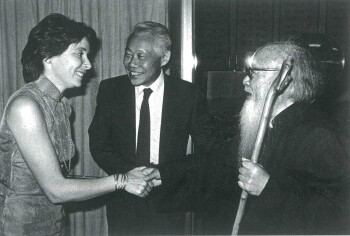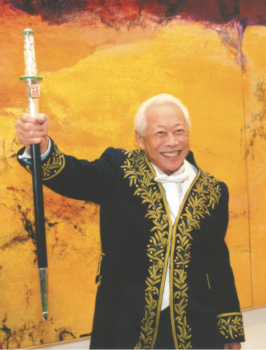Z ao Wou-Ki's artistic career spanned more than 60 years beginning 1948. While his painting style was firmly established in the 1950s and 1960s, it was decades later in the 1980s and 1990s that he became internationally renowned in Europe and the U.S., and in Asia. His art was enriched successively – from seeking essence of matter in the 1950s Klee period, and later in the 1960s reshaping the expressionistic elements in traditional Chinese calligraphy and landscape painting, moving into the study of space in the late 1970s, which then led to Zao’s comprehensive understanding of "presence and absence joined in a beautiful image” in Chinese aesthetics in the 1980s and 1990s.

Zao’s later works retain the tension of works from the 1960s, and at the same time elevate the expression of space. They represent the culmination of insights, techniques, and life experience accumulated over 50 years.
The later period of Zao Wou-Ki's works in the 1980s and 1990s were tremendously significant in establishing the artist's international recognition as well as extending his collector base from Europe and the U.S. to Asia. Click ahead to read about some of the artist's milestones.
- 1977
- 1981-1982
- 1983
- 1983
- 1998
- 2002
-
1977Zao Wou-Ki first exhibition in Japan at Fuji Television Gallery in Tokyo, marking his rising stature in Asia.
-
1981-1982Important travelling exhibition of Zao Wou-Ki from Galaries Nationales du Grand Palais in Paris to Fukuoka City Museum, Tokyo Nihonbashi Art Gallery, Fukui Prefectural Museum, Kyoto National Museum of Modern Art, Kamakura Museum of Modern Art, Hong Kong Arts Centre and to the National Museum Art Gallery in Singapore.
-
 1983In 1983, an exhibition was held in National Museum of History in Taiwan.
1983In 1983, an exhibition was held in National Museum of History in Taiwan.
Image caption: Françoise Marquet, Zao Wou-Ki, and Zhang Daqian in Taipei, 1983 -
1983On the invitation of the Chinese Minister of Culture, Zao exhibited in his native land for the first time since 1948, showing works at the National Museum in Beijing as well as at his alma mater in Hangzhou, which has since become the Zhejiang Academy of Fine Arts.
-
1998Zao travelled to China for a major retrospective organized by the AFAA, L’Oreal and the Shanghai Museum. It later toured to the National Art Museum of China in Beijing, and Guangdong Museum of Art.
-
 2002Zao Wou-Ki was elected to the French Academy of Fine Arts.
2002Zao Wou-Ki was elected to the French Academy of Fine Arts.
Image caption: Zao Wou-Ki at Galarie National du Jeu Paume with his academician's sword, 26 November 2003. (Photo by Dennis Bouchard)
Zao made many trips to China in the 1980s and 1990s, which provided a source of renewed inspiration for his work during this time. In the essay “Zao Wou-Ki, Painter Without Limits,” art critic Yann Hendgen wrote that the artist returned to Paris from his travels in China, bursting with inspiration.
“[Zao's travels to China] launched an important creative period for him, and he completed several large paintings, as if trying to make up for lost time. These paintings reaffirmed the artistic tensions in his previous pieces, while adding a comprehension of space that imbued the idea of the void with more meaning: space was truly an important compositional element, giving his work depth and distance.”

Zao’s later works retain the tension of works from the 1960s, and at the same time elevate the expression of space From the 1980s to the 1990s, we see an abstract master working precisely in the way he wanted.
Many of Zao’s large works were painted during these two decades. In 1985, Zao’s friend I.M. Pei invited him to paint a large work for the Raffles City Singapore project the noted architect was designing. Juin-Octobre 1985 was the largest painting of Zao’s career, measuring more than ten metres long. This important opportunity revealed that Zao had made a breakthrough in his understanding of space in his late career. This work became one of the most expensive pieces of Asian art after it sold for more than 500 million HKD at Sotheby’s in October 2018.
Presence and Absence
04.08.98 represents is a capstone in Zao’s half-century artistic career, embodying the union of presence and absence that he always pursued in his abstract works. The expression of space had long been Zao’s focus.
“I admire Mi Fu’s organization of space and Ni Yunlin’s treatment of the looser areas, which show the differences between Chinese landscape painting and Western oil painting. Many places in my paintings seem very empty, but it’s easier to add washes in ink than in oil paint, so I put more work into the empty spaces than the filled ones. In Chinese painting, the rhythms formed by presence and absence, as well as the constant movement that is created as one drives the other, transformed the areas of lightness and heaviness in the painting into points of interest. I have found this part of tradition immensely inspiring, and if my paintings are different from those of most Western painters, it is generally because of this treatment of space.”
04.08.98 presents a lively rhythm. Balancing a strong tension and a light tempo, this work reflects Zao’s theory about presence and absence in oil paintings. The intersection of dense and sparse brushwork, thick and thin areas of oil paint, and light and shadow create a sense of space that is integrated despite its disparate appearance. Perhaps an extension of Zao’s reinterpretation of Song-era landscapes, an endeavour he had undertaken in the 1960s, this painting seems to contain three different perspectives: looking upward, looking straight ahead, and looking downward. The shifting point of view produces a distinctive spatial structure and highlights a rhythmic vitality. He did not stop there; Zao employed the idea of “fewer chapped strokes and more ink,” almost invoking the depth of space created by the continuous mountain mists in Xia Gui’s Pure and Remote View of Streams and Mountains.
The ‘Five Colours of Ink’
Zao Wou-Ki chose “more ink” in his treatment of space, which means that his later work showed a notable shift in his creation of space through colour. He applied his theory of presence and absence, as well as the “five colours of ink,” to his oil paintings, producing ever-changing rhythms. While his paintings were rooted in Chinese traditional aesthetics, Zao created a meaningful dialogue between ‘five colours on ink’ in Chinese ink painting theory and Impressionism in Western art.
Zao fully exploited all the possibilities of ink: dry, moist, heavy, light, and charred. In the center of 04.08.98, he made a horizontal stroke of “moist and charred” thick, textured black oil paint on the canvas. Below that lies a thin field of “dry and light” black. The two complement one another, and the astonishing interaction of presence and absence here is immediately evident, giving the painting rhythm and depth.
This philosophy of presence and absence in ink and wash was applied to the black paint that broke through the horizon line and pierced the space; Zao also used this idea to control the texture of the gold, pearl white, and ivory oil paint, allowing the pigments to flow over the canvas, like a Chinese brush moving smoothly over paper. He created a fluid, expansive effect, like flowing sand. The seemingly molten pigments collide, creating new colours, such as pale pink, lilac, cerulean, and mauve, which intensifies the light in the work. Upon closer inspection, the rippling, damp effect gives the impression of paint lightly mingled with ink.
The Image Beyond the Image
Zao achieved a richer inner world in the 1990s than he had previously experienced. Zao embraced the use of negative space on his canvases, and without interwoven lines and symbols, it was the true test of the essence of abstract painting. After 50 years of art and life, Zao successfully mastered the union of “presence and absence” which was “the image beyond the image.” At this juncture, he departed from his intention of reworking Chinese landscapes, which had been his focus in the 1960s. He infused external forms with his moods to convey the difference between the concept of the unity of man and nature in Eastern philosophy, while also emphasizing form and expression in Western abstraction. In the creative process, Zao liked to contemplate his paintings and explore his feelings, which allowed his emotions to interact with the works. In the fusion of Chinese and Western aesthetics, Zao gradually moved from the real to the illusory and deepened his work from the inside out. In departing from pure Abstract Expressionism, his work became an intersection of the tangible real world and the intangible spiritual realm.
The Modern Art Evening Sale will be live streamed on 5 October at 7pm. Viewers will be able to access the multi-camera auction on the page linked below.








